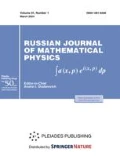Il y a quelque choseà faire. (French proverb)
Abstract
We develop the unbounded probability theory on the basis of Kolmogorov complexity and show its connections to thermodynamics, economics, and its role in the study of the Web.
Similar content being viewed by others
References
H. Poincaré, On Science(Izd. Nauka, Moscow, 1983) [in Russian] (Russian translation of the books Science et Hypothèse, Valeur de la Science, Science et Méthode, Derniéres Pensées).
A. A. Guseinov, Great Prophets and Thinkers, Ethical Studies from Moses to the Present Day (Moscow, Veche Editions, 2009).
V. V. Kozlov, “Kinetics of Collision less Gas: Equalization of Temperature, Growth of the Coarse-Grained Entropy and the Gibbs Paradox,” Regul. Chaotic Dyn. 14(4–5), 535–540 (2009).
V. P. Maslov, “Solution of the Gibbs Paradox in the Frame Work of Classical Mechanics (Statistical Physics) and Crystallization of the Gas C 60,” Mat. Zametki 83(5), 787–791 (2008) [Math. Notes 83 (5–6), 716–722 (2008)].
V. P. Maslov, “Solution of the Gibbs Paradox Using the Notion of Entropy as a Function of Fractal Dimension”, Russ. J. Math. Phys. 17(3), 251–261 (2010).
V. P. Maslov, “Gibbs Paradox, Liquid Phase as an Alternative to the Bose Condensate, and Homogeneous Mixtures of New Ideal Gases,” Math. Notes, 89(3), 366–373 (2011).
V. P. Maslov, “Critical Exponents as the Wiener Quantization of Thermodynamics,” Teoret. Mat. Fiz. 170(3), 458–470 (2012) [in Russian].
V. P. Maslov, “Degeneration in the Transition from the Discrete Spectrum to the Continuous One and the Transition from Quantum Mechanics to Classical Mechanics,” Dokl. Akad. Nauk SSSR 114(5), 957–960 (1957) [in Russian].
T. V. Maslova, “A Refinement of the Zipf Law for Frequency Dictionaries,” NTI Ser. 2 37(11), (2006) [Scientific and Technical Information Processing (11), (2006)].
P. Erdős, and J. Lehner, “The Distribution of the Number of Summands in the Partitions of a Positive Integer,” Duke Math. J. 8(2), 335–345 (1941).
V. P. Maslov, “Unbounded Probability Theory Compatible with the Probability Theory of Numbers,” Math. Notes 91(5), 603–609 (2012).
V. P. Maslov, “Bose Condensate in the D-Dimensional Case, in Particular, for D = 2,” Russ. J. Math. Phys. 19(3), 317–323 (2012).
L. D. Landau, and E. M. Lifshits, Statistical Physics (Nauka, Moscow, 1964) [in Russian].
V. P. Maslov, Zeno-line, Binodal, T − ρ Diagram and Clusters as a new Bose-Condensate Bases on New Global Distributions in Number Theory (arXiv:1007.4182v3 [math-ph], 2010).
K. Davitt, E. Rolley, F. Caupin, A. Arvengas, and S. Balibar, “Equation of State of Water Under Negative Pressure,” J. Chem. Phys. 133(174507), 1–8 (2010).
V. G. Baidakov, and S. P. Protsenko, “Singular Point of a System of Lennard-Jones Particles at Negative Pressures,” Phys. Rev. Lett. 95(1.015701), (2005).
K. I. Shmulovich, and L. Mercury, “Geochemical Processes at Negative Pressures,” Electronic Scientific Information Journal “Herald of the Departure of Earth Sciences RAS” 1(24), 1–3 (2006).
L. P. Filippov, Law of Corresponding States (Izd. Moskov. Univ., Moscow, 1983) [in Russian].
E. M. Apfelbaum, and V. S. Vorob’ev, “Correspondence between the Critical and the Zeno-Line Parameters for Classical and Quantum Liquids,” J. Phys. Chem. B, 113(11), 3521–3526 (2009).
E. M. Apfelbaum, and V. S. Vorob’ev, “The Confirmation of the Critical Point-Zeno-Line Similarity Set from the Numerical Modeling Data for Different Interatomic Potentials,” J. Phys. Chem. 130(21), (1–10) (2009).
V. P. Maslov and V. V. V’yugin, “Variational Problems for Additive Loss Functions and Kolmogorov Complexity,” Dokl. Ross. Akad. Nauk 390(5), 595–598 (2003) [Russian Acad. Sci. Dokl. Math. 67 (3), 404–407 (2003)].
V. P. Maslov and V. V. Vyugin, “Concentration Theorems for Entropy and Free Energy,” Problemy Peredachi Informatsii 41(2), 72–88 (2005) [Probl. Inf. Transm. 41 (2), 134–149 (2005)].
L. P. Filippov, Law of Corresponding States (Izd. Moskov. Univ., Moscow, 1983) [in Russian].
V. P. Maslov, “New Probability Theory Compatible with the New Conception of Modern Thermodynamics. Economics and Crisis of Debts,” Russ. J. Math. Phys. 19(1), 63–100 (2012).
Author information
Authors and Affiliations
Additional information
This work was partially supported by the RFBR grant 11-01-12058_ofi_m.
Rights and permissions
About this article
Cite this article
Maslov, V.P., Maslova, T.V. Probability theory for random variables with unboundedly growing values and its applications. Russ. J. Math. Phys. 19, 324–339 (2012). https://doi.org/10.1134/S1061920812030065
Received:
Published:
Issue Date:
DOI: https://doi.org/10.1134/S1061920812030065



